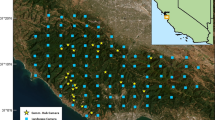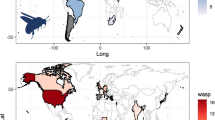Abstract
The biological invasion of the glassy-winged sharpshooter, Homalodisca coagulata, into French Polynesia presents a novel threat to Pacific Island ecosystems. Widely known as an agricultural pest because of its role as a vector of numerous lethal plant diseases, H. coagulata may pose a substantial and immediate risk to arthropod predators on invaded islands in French Polynesia. Controlled feeding experiments revealed that island spiders can be killed following predation on H. coagulata. Spider mortality appeared to result from lethal intoxication, although no form of chemical defense has been reported in H. coagulata. In the two spider species tested, approximately half of all individuals that attacked H. coagulata nymphs or adults died. As populations of this insect increase in size and range on invaded islands in French Polynesia, H. coagulata will increasingly encounter these and other arthropod predators, raising the possibility of population-level impacts on susceptible predator species. Field surveys of island spiders across nine sites on H. coagulata-invaded and H. coagulata-uninvaded islands suggest that this insect may already have adversely impacted an endemic spider on at least one island. Work is needed to identify the nature of the lethal agent harbored within H. coagulata and the taxonomic and geographic breadth of predators vulnerable to it. The generality of H. coagulata-lethality and the capacity of afflicted predator species for population-level adaptation or learned avoidance in response to this spreading pest will determine the magnitude of the threat H. coagulata poses in the South Pacific.
Similar content being viewed by others
References
Bais HP, Vepachedu R, Callaway RM and Vivanco J (2003). Allelopathy and exotic plant invasion: from molecules and genes to species interactions. Science 301: 1377–1380
California Department of Food and Agriculture (2004) http://pi.cdfa.ca.gov/pqm/manual/htm/454.htm#appendixa
Callaway RM and Aschehoug ET (2000). Invasive plants versus their new and old neighbors: a mechanism for exotic invasion. Science 290: 521–523
Callaway RM and Ridenour WM (2004). Novel weapons: a biochemically based hypothesis for invasive success and the evolution of increased competitive ability. Frontiers of Ecological Environment 2: 436–443
Darwin C (1859). On the Origin of Species by Means of Natural Selection. John Murray, London
Elton CS (1958). The Ecology of Invasions. Methuen, London
Gillespie RG, Roderick GK, Arnedo MA, Shapiro L, Bely A, Garb JE and Spagna J (2000) Spiders, planthoppers, and flies of French Polynesia. Haut-Commissaire de la Republique en Polynesie Francaise
Heu RA, Kumashiro BR, Suh TH, and Bautista RC (2004) Glassy-winged sharpshooter, Homalodisca coagulata (Say) (Homoptera: Cicadellidae). State of Hawaii Department of Agriculture, New Pest Advisory, Number 04–02 http://www.hawaiiag.org/hdoa/npa/npa04-02-GWSS.pdf
Hoddle MS (2004). The potential adventive geographic range of glassy-winged sharpshooter, Homalodisca coagulata and the grape pathogen, Xylella fastidiosa: implications for California and other grape growing regions of the world. Crop Protection 23: 691–699
Holt RD (1984). Spatial heterogeneity, indirect interactions and the coexistence of prey species. Am. Nat. 124: 377–406
Holt RD and Lawton JH (1993). Apparent competition and enemy-free space in insect host-parasitoid communities. American Naturalist 142: 623–645
Holway DA, Suarez A and Case TJ (1998). Loss of intraspecific aggression in the success of a widespread invasive social insect. Science 282: 949–952
Hopkins DL and Purcell AH (2002). Xylella fastidiosa: cause of Pierce’s Disease of grapevine and other emergent diseases. Plant Disease 86: 1056–1066
Jeffries MJ and Lawton JH (1984). Enemy-free space and the structure of ecological communities. Biological Journal of Linnean Society 23: 269–286
Johnson LE and Carlton JT (1996). Post-establishment spread in large-scale invasions: dispersal mechanisms of the zebra mussel Dreissena polymorpha. Ecology 77: 1686–1690
Keane S and Crawley P (2002). Exotic plant invasions and the enemy release hypothesis. Trends Ecol. Evol. 17: 164–170
Levine JM, Vila M, D’Antonio CM, Dukes JS, Grigulis K and Lavorel S (2002). Mechanisms underlying the impacts of exotic plant invasions. Proceedings of the Royal Society of London Series B 270: 775–781
Lodge DM (1993). Species invasions and deletions: community effects and responses to climate and habitat change. In: Kareiva, PM, Kingsolver, JG and Huey, RB (eds) Biotic Interactions and Global Change, Sinauer, Sunderland, MA 367–387
Louda SM, Keeler KM and Holt RD (1990). Herbivore influences on plant performance and competitive interactions. In: Grace, JB and Tilman, D (eds) Perspectives on Plant Competition, Academic Press, Elsevier, Amsterdam 414–444
Mack RN, Simberloff D, Lonsdale WM, Evans H, Clout M and Bazzaz FA (2000). Biotic Invasions: causes, epidemiology, global consequences, and control. Ecological Application 10: 689–710
Mitchell CE and Power AG (2003). Release of invasive plants from fungal and viral pathogens. Nature 421: 625–627
Moran NA, Dale C, Dunbar H, Smith WA and Ochman H (2003). Intracellular symbionts of sharpshooters (Insecta: Hemiptera: Cicadellinae) form a distinct clade with a small genome. Environmental Microbiology 5: 116–126
Oliver KM, Russell JA, Moran NA and Hunter MS (2003). Facultative bacterial symbionts in aphids confer resistance to parasitic wasps. Proceedings of the National Academy of Sciences USA 100: 1803–1807
Platnick NI (2004) The World Spider Catalog, version 5.0. American Museum of Natural History, http://research.amnh.org/entomology/spiders/catalog/index.html
Porter SD, Williams DF, Patterson RS and Fowler HG (1997). Intercontinental differences in the abundance of Solenopsis fire ants (Hymenoptera: Formicidae): escape from natural enemies?. Environ. Entomol. 26: 373–384
Purcell AH (1997). Xylella fastidiosa, a regional problem or global threat?. Journal of Plant 79: 99–105
Raven JA (1983). Phytophages of xylem and phloem: a comparison of animal and plant sap-feeders. Advances in Ecological Research 13: 135–234
Ridenour WM and Callaway RM (2001). The relative importance of allelopathy in interference: the effects of an invasive weed on a native bunchgrass. Oecologia 126: 444–450
Secretariat of the Pacific Community (2002) Incursion of glassy-winged sharpshooter Homalodisca coagulata in French Polynesia. Pest Alert, Plant Protection Service http://www.spc.org.nc/pps/PestAlerts/PestAlertNo24.pdf
Sheley RL, Jacobs J and Carpinelli MF (1998). Distribution, biology, and management of diffuse knapweed and spotted knapweed. Weed Technology 12: 353–362
Simpson AJ, Reinach FC, Arruda P, Abreu FA, Acencio M, Alvarenga R, Alves LMC, Araya JE, Baia GS and Baptista CS (2000). The genome sequence of the plant pathogen Xylella fastidiosa. Nature 406: 151–157
Sorensen JT and Gill RJ (1996). A range extension of Homalodisca coagulata (Say) (Hemiptera: Clypeorrhyncha: Cicadellidae) to Southern California. Pan-Pacific Entomologist. 72: 160–161
Strayer DL, Smith LC and Hunter DH (1998). Effects of the zebra mussel (Dreissena polymorpha) invasion on the macrobenthos of the freshwater tidal Hudson River. Sanadian Journal of Zoology 76: 419–425
Torchin ME, Lafferty KD, Dobson AP, McKenzie VJ and Kuris AM (2003). Introduced species and their missing parasites. Nature 421: 628–630
Vickerman DB, Hoddle MS, Triapitsyn S and Stouthamer R (2004). Species identity of geographically distinct populations of the glassy-winged sharpshooter parasitoid Gonatocerus ashmeadi: morphology, DNA sequences, and reproductive compatibility. Biological Control 31: 338–345
Vivanco JM, Bais HP, Stermitz FR, Thelan GC and Callaway RM (2004). Biogeographical variation in community response to root allelochemistry: novel weapons and exotic invasion. Ecological Letters 7: 285–292
Wells JM, Raju BC, Hung HY, Weisburg WG, Madelco-Paul L and Brenner DJ (1987). Xylella fastidiosa gen. nov., sp. nov.: gram-negative, xylem-limited, fastidious plant bacteria related to Xanthomonas spp. International Journal of Systematic Bacteriology 37: 136–143
Author information
Authors and Affiliations
Corresponding author
Rights and permissions
About this article
Cite this article
Suttle, K.B., Hoddle, M.S. Engineering Enemy-free Space: An Invasive Pest that Kills its Predators. Biol Invasions 8, 639–649 (2006). https://doi.org/10.1007/s10530-005-1856-y
Received:
Accepted:
Published:
Issue Date:
DOI: https://doi.org/10.1007/s10530-005-1856-y




